We've been home for four days now and are mostly recovered from a twenty-two-hour travel day, plus many hours of awake time, housework, groceries, etc. so, it's about time to finish the last post for this trip.
KOPER (Slovian Name)/CAPODISTRIA (Italian Name)
Koper is also known as "Vienna by the Sea" or the "City of Coffee". Funnily enough, our accommodation, for the first time, has lots of teabags, but no coffee or coffee-making supplies. It's the oldest city in Slovenia.
Its history dates to 1500 BC. In Roman times, for the Venetian Republic, it functioned as the capital for the Istria region. It was once a fortified island, but in 1825, the Romans built a causeway to connect it to the mainland, and over the centuries, through drainage and land reclamation efforts, the sea was filled in, and the connection to the mainland was complete.
The legend of the origin of the island of Koper goes something like this: Athena (the Greek goddess of wisdom) had a row with Poseidon (the Greek god of the sea). During a physical battle, Athena's shield fell into the sea and transformed itself into an island.
The Port of Koper is the biggest and busiest port in Slovenia and in the Adriatic Sea. It provides a gateway to Central Europe, China, and other global markets.
In the heart of Old Town, in Tito trg (square) is the Loggia Palace. This is the only preserved Gothic hall in all of Slovenia. Part of the building dates to 1412. Today, on the second floor is an art gallery and on the first floor is a cafe under the arches that, in good weather, spills out onto the square.
The former Praetorian Palace now houses the Tourist Information Center and part of the University of Primorska.
Another historic building in Tito Square is the Cathedral of Mary's Assumption and its Clock Tower. In the 12th century, the tower was a stand-alone city tower. With renovations in the 15th century, it was connected to the Cathedral.
The photo below is from the Wikimedia Commons site by photographer Earnest B and is used with permission under the following license: https://en.wikipedia.org/wiki/GNU_Free_Documentation_License
Part of the ancient fortification wall and its Muda Gate still stands as an entry gate to Presernov trg; however a new gate now butts up to it. This square is named after the great Slovenian poet France Preseren. It was once the 'passage' that connected the island with the 'outside world' and the trading that went on there was of primary importance to the development of Koper. Muda Gate is the only preserved town gate of which there were formerly twelve, built in the 16th century.
The fountain has four mascarons (faces) from which the water emanates.
On our arrival, Koper is hosting Eurofest. Three thousand people are here to watch and cheer on two hundred teams of handball players aged 13 to 18 years from all over Europe. We have never seen this game before and are surprised at the amount of body contact in the game. The court at the waterfront always has a game on, but the games are spread throughout the city.
Between games, youth can jump in the water to cool off as Koper City Beach is right there with its blue floating rafts. The weather is quite warm for playing such a physically active game.
The first evening hosts the parade of athletes at the waterfront. At dusk, this day the sunset is stupendous.
Each team tries to bring something unique to the parade, whether it's someone driving an antique car, a team cheer or song, and a few teams had some members in costume. Everyone enjoys the parade and enthusiastically greets each team. One man brings a drum to create lots of attention with each new team that passes by.
These stilt-walkers look more comfortable in their gear, than the old wooden ones we are used to seeing.
Before the parade, there is some entertainment, first, a magician.
As night falls, the atmosphere remains festive. Pop-up bars, some with live music. Souvenir and food stalls were everywhere.
The ships at sea and the port were lit up. The evening was gloriously warm.
The main square at the port curls around into a wide promenade that must be over a kilometre in length. It leads to Zusterna Beach, a pebbly, yet family-friendly beach with green space and places to eat fast food, as well as relax with a drink.
When the island was filled in to become part of the mainland, it was largely salt pans that were filled in. Salt production, practiced in the centuries-old manner, is still carried out on the peninsula in Slovenia and Croatia.
While wandering the streets of Old Town, we come upon the store for the Aura Family Distillery (from the Istria Peninsula in Croatia). We saw one of their shops in Izola too, but didn't go in. It's worth going in just to see the decor.
In addition to twenty-five flavours of brandies and liquors and four types of gin, this family makes nine flavours of jam. It also carries Extra Virgin Olive Oil and Istrian salt, many different types are done up for gift-giving, soap and other interesting items.
A poet by the name of Zulfiqar hamdam awan published a lovely poem on the All Poetry website about the country called "Enchanted Slovenia".
You can go here to read it.
TRIESTE/CAPODISTRIA
The most economical way to fly home is from the port town of Trieste, in Italy's small portion of the Istria Peninsula, and so, we are here for a day and half. The population is 200,000+.
Our room is a short walk from the main square and waterfront, yet is located in an area of town that is more affordable for food and drink, including storefront eateries and little markets with ethnic foods.
Trieste is spread out, so the first thing we do is sign up for a Hop On, Hop Off bus tour. This enabled us to see things that we would not walk to.
The next two photos were taken from the window of a moving bus.
The Roman Theatre
Built during the 1st and 2nd centuries CE when the city was known as Tergeste, it could accommodate 6,000 spectators. It is set into the slope of a hill, facing the sea. Since being partially restored, it occasionally hosts cultural events and performances.
Here lie the remains of the ancient Roman city of Tergeste. They span several centuries of Roman occupation, with remains of a basilica, houses and public buildings that leave a clear impression of what life was like back then. It is one of the most complete archaeology sites in north-eastern Italy.
Castello Miramare
This castle sits on a rock jutting out to look over the Gulf of Trieste on 22 hectares of land. The Archduke Ferdinad Maximillian of Austria had it built as a home for him and his wife. Today, it is a museum, complete with period furnishings.
The photo below of the castle, taken by Diego Baglieri is found on the Wikimedia Commons site and is used with permission under the following attribution
At 223 feet, this is one of the tallest lighthouses in the world. It was built (from 1923 to 1927) to memorialize those who died at sea during WWI. The front has the sculpture of a seaman and the anchor of an Italian WWI ship. The winged Victory figure stands on the top of the lighthouse. Everything about the lighthouse has layers of meaning from where its situated, to the materials used in its construction. It's worth it to do a bit of reading about this symbol of Italian pride and victory. People can visit the bottom part of the lighthouse.
The photo below of the lighthouse, taken by Molino8 is found on the Wikimedia Commons site and is used with permission under the following attribution
Immediately finishing the tour, we head to the heart of Old Town and the Piazza Unita d'Italia (Unity of Italy Plaza). It is breathtaking in size and is one of the largest in Europe that faces the sea. Throughout history, it has been the venue for many historical events and concerts.
Most of the buildings surrounding the plaza are stunning. Here are a few:
City Hall
Tourists cannot go up into the clock/bell tower as it is a working government building; however, the Tourist information center is here.
Other significant statues in the Unity Plaza include:
-One of the Emperor Charles VI (of Hapsburg dynasty) who granted Trieste the status of a Free port. By favouring the port of Trieste over that of Venice, the Emperor laid the groundwork for the future prosperity of Trieste and the beginning of modernization of the city.
-Ones of Soldiers (war memorials)
And the column of the Holy Roman Emperor Leopold I of Austria of the House of Hapsburg who ruled for forty-six years.
Then there is the Lloyd Triestino building (Palazzo della Regione) which previously the head office of the Italia Marittima, and is now the seat of the regional government of Fruili Venezia Giulia.
The beautiful Pallazzo del Governo (Government Palace), designed by a Viennese architect and built from 1901 to 1905, now houses the offices of the Italian Government Commissioner.
Canal Grande is halfway between the railway station and Piazza Unita. It was built from 1754 to 1756 so boats could come into the heart of the city to unload/load their goods. Today it is a non-functioning port and a pleasant place to hang out with cafes, bars, restaurants and beautiful buildings lining it.
Other beautiful buildings outside of Unity Plaza
The Palazzo Arrigoni & Statue of Zeus on rooftop
The Aquarium is closed for a while for renovations. It has twenty medium and several large tanks, plus a large oceanic tank with species of the Adriatic Sea. All of the water in all of the tanks is from the Adriatic, including the natural plankton, minerals and nutrients in the water.
A section holds reptiles and amphibians typical of the area, and karst ponds have been recreated.
Former Fish Market, now the Salone degli Incanti
This beautiful building was constructed in 1913 for use as a fish market. Today it is used as an exhibition space for modern and contemporary art, for cultural activities and social gatherings. The large windows are perfect for such uses. What we loved about it are the different sea creatures depicted in decoration at the top of the building (see first photo below)
in 1872, Baron Pasquale Revoltella bequeathed his palace, art collection and a significant amount of money to the City of Trieste. Today, it is recognized as making a significant contribution to modern art. The bigger-than-life statues on the roof caught our eye.
Only one more building. We are impressed by how this new and modern building has been built into ancient ruins.
During the time we are here, this motor sailing superyacht (Sailing Yacht A) owned by Russian billionaire Andrey Melnichenko is in the bay. It is one of the biggest of its kind in the world, at 469 feet long, and the longest mast is 328 feet tall. The ship was temporarily seized (in March of 2022) as part of EU sanctions against Russia's invasion of Ukraine.
Trieste has a long and interesting history, and so there are many legends, poems and songs written about it that can be found on the internet.


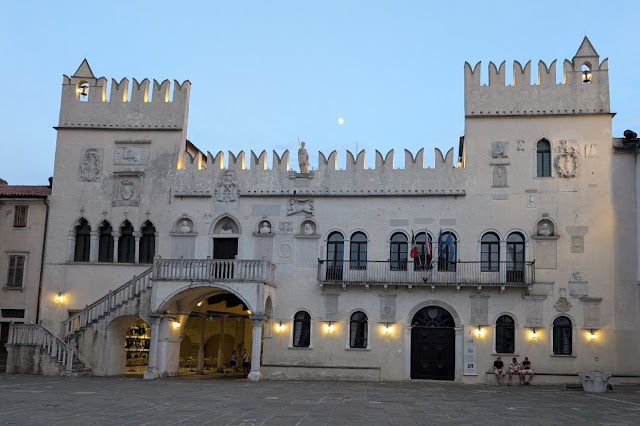
.jpg)


















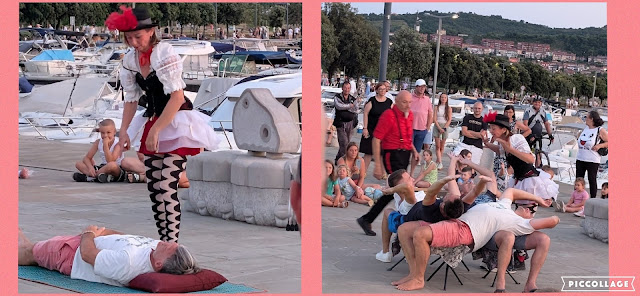

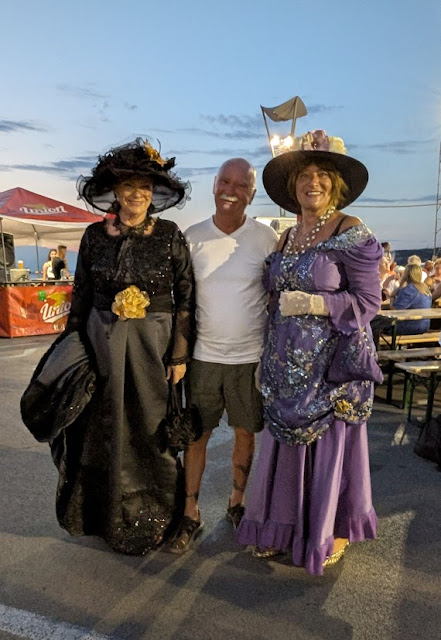













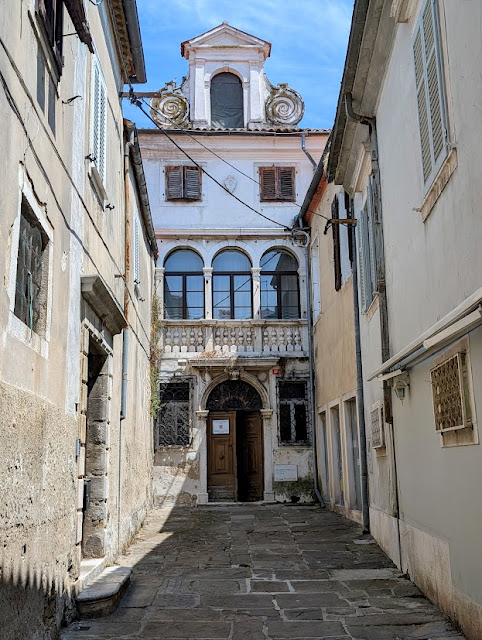




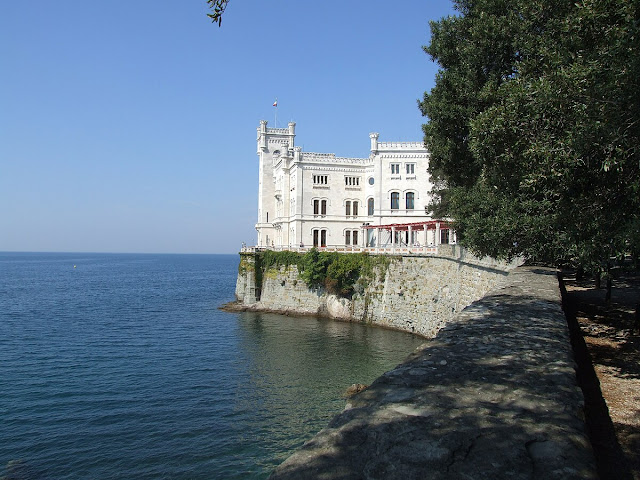

























No comments:
Post a Comment